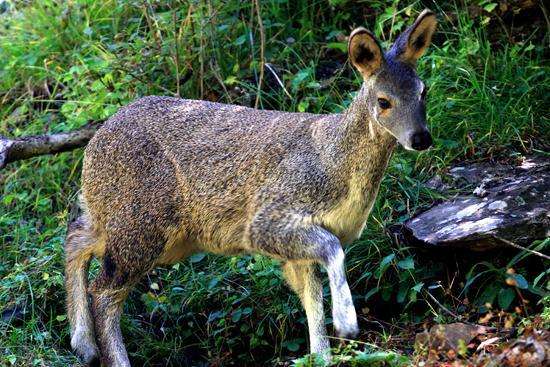Dwarf musk deer
IUCN
LCBasic Information
Scientific classification
- name:Dwarf musk deer
- Scientific Name:southern musk deer, forest musk deer, black musk deer, forest musk deer, musk deer
- Outline:Ungulata
- Family:Artiodactyla Moschidae Moschus
Vital signs
- length:63-80cm
- Weight:6-9kg
- lifetime:18-20 years
Feature
The smallest species of musk deer
Distribution and Habitat
Native distribution: China, Vietnam.
In China, it is mainly distributed in Ningxia Liupan Mountain and Shaanxi Qinling Mountains; east to Anhui Dabie Mountain and western Hunan; west to Sichuan, Tibet Bomi, Chaou, northern Yunnan; south to Guizhou, Guangdong and northern mountainous areas of Guangxi.
It mainly lives in coniferous and broad-leaved mixed forests, and is also suitable for living in coniferous forests and broad-leaved forests with poor canopy density. The habitat altitude can reach 2000~3800 meters, but it can also survive in low-altitude environments.
Appearance
Both sexes are hornless; ears are long and erect, with slightly rounded ends. Male musk deer have well-developed large teeth on the upper part, which bend backward and downward and extend out of the lips; there is a musk sac in front of the genitals on the abdomen, and the tail is thick and short, with well-developed uropygial glands. The limbs are slender, and the hind limbs are longer than the front limbs.
The body hair is coarse and dark, olive brown, and dyed with orange-red. The inside of the ears and eyebrows are white; the ear tips are black, and the base is orange-brown; there is a clearly defined white or orange-yellow area between the lower jaw, throat, under the neck and even the front chest, and the lower jaw has a cream-colored stripe; the cream-colored spots on the sides of the throat are connected to form two cream-colored bands, from the front of the neck down to the chest, and in the middle and upper part of the neck is a dark brown wide band in contrast. The legs a
Details
The foreign name of Forest Musk Deer is Forest Musk Deer. There are 5 subspecies, and the most famous "musk" is produced by it.

The forest musk deer is a timid and solitary animal. It rests during the day and comes out in the morning and evening. Usually, males and females live separately and live alone. Female musk deer often stay with young musk deer, while male musk deer use their huge musk glands to mark their territory and attract mates. Musk deer have keen vision and hearing, and they will quickly escape or hide in rocks when they encounter special sounds. They can walk briskly and swiftly on steep cliffs, climb inclined tree trunks, stand on branches, and are good at jumping, and can jump more than 2 meters from the ground.
Musk has a wide range of uses. It can be used as a fixative, stimulant, or to prepare emergency medicines such as cardiotonic drugs. It has extremely high economic and medicinal value. The yield of pure natural musk is extremely low. Generally, 60 musk deer are needed to extract one kilogram of musk. In order to obtain enough musk, humans hunt arbitrarily, resulting in a large reduction in the number of musk deer. At present, musk deer has been listed as a national first-class key protected wild animal. It is not surprising that they are extremely vigilant against humans. We have hurt them too deeply.
In the 30 years from the 1950s to the 1980s, among the 77 counties where musk deer were originally distributed in Guangxi, musk deer had become extinct in 15 counties and were on the verge of extinction in 16 counties. A study in 2006 showed that the distribution area of musk deer in Feng County, Shaanxi Province had dropped to 34% of that 50 years ago. Musk deer in Shanxi, Gansu, Ningxia, Guangxi and other places are on the verge of extinction or have already become extinct! At present, the amount of wild musk deer resources has dropped by nearly 90%. In Chongqing, the number of wild musk deer is less than 100, and only a small number are distributed in Daba Mountain and Jinfo Mountain.
Now, the artificial breeding technology of musk deer is still being improved. With the participation of more and more scholars, as the world's leading musk exporting country, I believe that musk deer resources will be well protected and sustainable development will be achieved.
Listed in Appendix II of the Convention on International Trade in Endangered Species of Wild Fauna and Flora (CITES).
Listed in the List of National Key Protected Wildlife: National First-Class Protected Animal (effective December 10, 1988). (Note: All species of musk deer)
Listed in the IUCN Red List of Endangered Species: Endangered Species (EN), assessed in 2008.
Listed in the First Class of the List of National Key Protected Wildlife in China.
Protect wild animals and stop eating game.
Maintaining ecological balance is everyone's responsibility!








